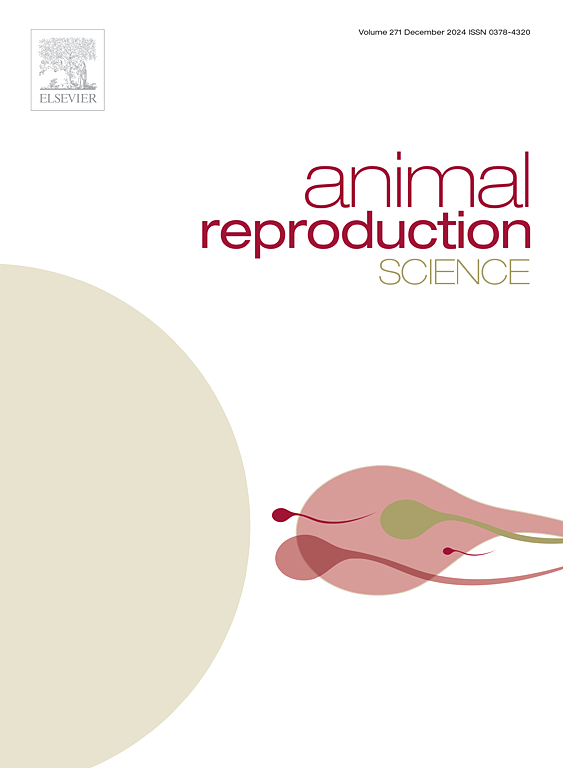The surface proteome of rabbit spermatozoa
IF 2.2
2区 农林科学
Q1 AGRICULTURE, DAIRY & ANIMAL SCIENCE
引用次数: 0
Abstract
Cell surface proteins, targeted by approximately 70 % of current pharmaceuticals, offer promising prospects for therapeutic and biotechnological advancements. The recent identification of cell surface proteins, differentially expressed by rabbit spermatozoa, could support technologies to enable sperm sex selection. However, a more detailed knowledge of the rabbit sperm plasma membrane proteome is crucial to such developments. Hence, the primary objective of this study was to conduct a shotgun proteomic (LC-MS/MS) analysis of New Zealand White rabbit spermatozoa protein lysates enriched in cell surface proteins isolated through biotinylation. This approach was designed to provide an overall characterization of this proteome and so determine an expanded list of protein candidates with potential for rabbit sperm sexing. The most promising targets were identified through functional annotation (UniProt and eggNOG-mapper v.2.1.9) and topology prediction (DeepTMHMM v.1.0.13). Additionally, a statistical overrepresentation test (PANTHER 18.0) and analysis of protein–protein interactions (STRING v.12.0) were conducted. Among the 859 detected proteins, 803 had Gene Ontology information, with 574 predicted as globular proteins, 152 as transmembrane proteins, and 133 possessing only a signal peptide. The combined data identified 107 proteins as potential cell surface targets, including three transmembrane proteins encoded by the X chromosome (ADGRG2, ATP6AP2, and VSIG1). Furthermore, two proteins (BCAP31 and PGRMC1), previously identified as putative rabbit X-targets, were recognized. This study enhances our comprehension of rabbit spermatozoa proteomics. Further validation of the utility of these five proteins to differentiate between X- and Y-sperm will determine their suitability for integration into sperm sexing technologies.
兔精子表面蛋白质组
细胞表面蛋白是目前约70% 药物的靶标,为治疗和生物技术进步提供了广阔的前景。最近对兔精子细胞表面蛋白差异表达的鉴定,可以支持精子性别选择的技术。然而,对兔精子质膜蛋白质组的更详细的了解对这种发展至关重要。因此,本研究的主要目的是对通过生物素化分离的富含细胞表面蛋白的新西兰大白兔精子蛋白裂解物进行散弹枪蛋白质组学(LC-MS/MS)分析。该方法旨在提供该蛋白质组的总体特征,从而确定具有兔精子性别鉴定潜力的候选蛋白质的扩展列表。通过功能注释(UniProt和eggNOG-mapper v.2.1.9)和拓扑预测(DeepTMHMM v.1.0.13)确定了最有希望的目标。此外,还进行了统计过代表性检验(PANTHER 18.0)和蛋白质相互作用分析(STRING v.12.0)。在检测到的859个蛋白中,803个具有基因本体信息,其中预测为球状蛋白574个,预测为跨膜蛋白152个,预测仅具有信号肽133个。综合数据鉴定出107种蛋白作为潜在的细胞表面靶点,包括3种由X染色体编码的跨膜蛋白(ADGRG2, ATP6AP2和VSIG1)。此外,之前被认为是兔x靶点的两个蛋白(BCAP31和PGRMC1)被识别出来。本研究提高了我们对兔精子蛋白质组学的认识。进一步验证这五种蛋白质区分X型和y型精子的效用,将确定它们是否适合整合到精子性别鉴定技术中。
本文章由计算机程序翻译,如有差异,请以英文原文为准。
求助全文
约1分钟内获得全文
求助全文
来源期刊

Animal Reproduction Science
农林科学-奶制品与动物科学
CiteScore
4.50
自引率
9.10%
发文量
136
审稿时长
54 days
期刊介绍:
Animal Reproduction Science publishes results from studies relating to reproduction and fertility in animals. This includes both fundamental research and applied studies, including management practices that increase our understanding of the biology and manipulation of reproduction. Manuscripts should go into depth in the mechanisms involved in the research reported, rather than a give a mere description of findings. The focus is on animals that are useful to humans including food- and fibre-producing; companion/recreational; captive; and endangered species including zoo animals, but excluding laboratory animals unless the results of the study provide new information that impacts the basic understanding of the biology or manipulation of reproduction.
The journal''s scope includes the study of reproductive physiology and endocrinology, reproductive cycles, natural and artificial control of reproduction, preservation and use of gametes and embryos, pregnancy and parturition, infertility and sterility, diagnostic and therapeutic techniques.
The Editorial Board of Animal Reproduction Science has decided not to publish papers in which there is an exclusive examination of the in vitro development of oocytes and embryos; however, there will be consideration of papers that include in vitro studies where the source of the oocytes and/or development of the embryos beyond the blastocyst stage is part of the experimental design.
 求助内容:
求助内容: 应助结果提醒方式:
应助结果提醒方式:


